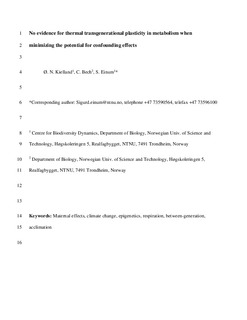| dc.contributor.author | Kielland, Øystein Nordeide | |
| dc.contributor.author | Bech, Claus | |
| dc.contributor.author | Einum, Sigurd | |
| dc.date.accessioned | 2017-09-27T06:41:57Z | |
| dc.date.available | 2017-09-27T06:41:57Z | |
| dc.date.created | 2017-01-11T14:30:36Z | |
| dc.date.issued | 2017 | |
| dc.identifier.issn | 0962-8452 | |
| dc.identifier.uri | http://hdl.handle.net/11250/2456922 | |
| dc.description.abstract | Environmental change may cause phenotypic changes that are inherited across generations through transgenerational plasticity (TGP). If TGP is adaptive, offspring fitness increases with an increasing match between parent and offspring environment. Here we test for adaptive TGP in somatic growth and metabolic rate in response to temperature in the clonal zooplankton Daphnia pulex. Animals of the first focal generation experienced thermal transgenerational ‘mismatch’ (parental and offspring temperatures differed), whereas conditions of the next two generations matched the (grand)maternal thermal conditions. Adjustments of metabolic rate occurred during the lifetime of the first generation (i.e. within-generation plasticity). However, no further change was observed during the subsequent two generations, as would be expected under TGP. Furthermore, we observed no tendency for increased juvenile somatic growth (a trait highly correlated with fitness in Daphnia) over the three generations when reared at new temperatures. These results are inconsistent with existing studies of thermal TGP, and we describe how previous experimental designs may have confounded TGP with within-generation plasticity and selective mortality. We suggest that the current evidence for thermal TGP is weak. To increase our understanding of the ecological and evolutionary role of TGP, future studies should more carefully identify possible confounding factors. | nb_NO |
| dc.language.iso | eng | nb_NO |
| dc.publisher | The Royal Society | nb_NO |
| dc.title | No evidence for thermal transgenerational plasticity in metabolism when minimizing the potential for confounding effects | nb_NO |
| dc.type | Journal article | nb_NO |
| dc.type | Peer reviewed | nb_NO |
| dc.description.version | acceptedVersion | nb_NO |
| dc.source.volume | 284 | nb_NO |
| dc.source.journal | Proceedings of the Royal Society of London. Biological Sciences | nb_NO |
| dc.source.issue | 1846 | nb_NO |
| dc.identifier.doi | 10.1098/rspb.2016.2494 | |
| dc.identifier.cristin | 1425173 | |
| dc.relation.project | Norges forskningsråd: 230482 | nb_NO |
| dc.description.localcode | (c) 2017 The Author(s) | nb_NO |
| cristin.unitcode | 194,66,10,0 | |
| cristin.unitname | Institutt for biologi | |
| cristin.ispublished | true | |
| cristin.fulltext | postprint | |
| cristin.qualitycode | 2 | |
